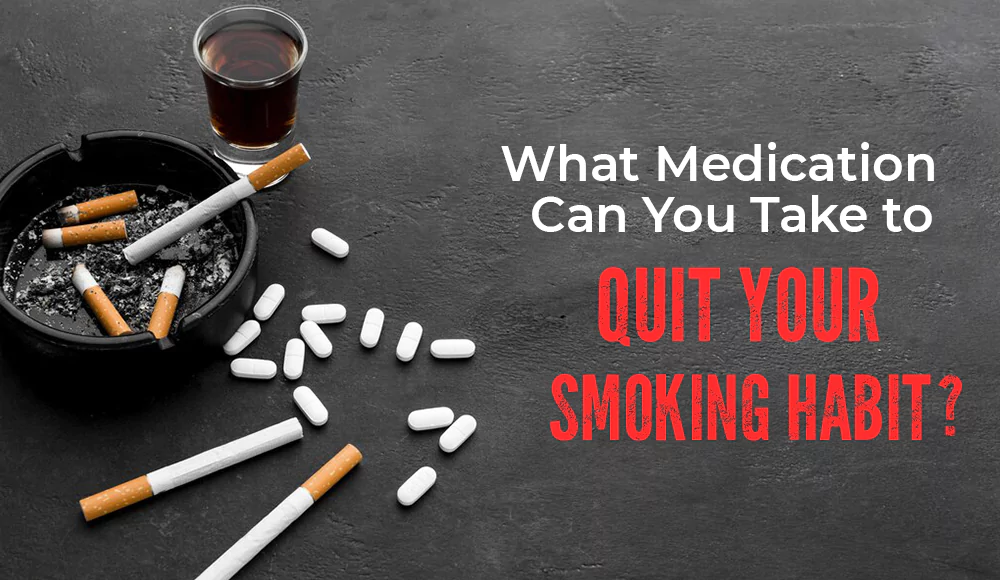
What Medication Can You Take to Quit Your Smoking Habit?We all know smoking is a bad habit. It has negative impacts on your health, wallet and social life. But quitting it? Well, it can feel like climbing Mount Everest in flip-flops.
Fear not, you’re not alone in this battle! There are powerful medications available to kick out your habit.
Let’s explore the top medication options that give your quit smoking attempts a serious boost.
What Are The Top Quit Smoking Medicines?
There are two categories of smoking cessation products available: one that contain nicotine and those that do not. Nicotine replacement therapy options, such as gums, lozenges, sprays and inhalers, deliver a small amount of nicotine without the harmful chemicals found in cigarettes, making them suitable for lighter smokers.
These products help you gradually reduce your nicotine dependence, easing withdrawal symptoms. However, they do not eliminate your smoking cravings. Most nicotine replacement therapies are available over-the-counter.
Additionally, there are prescription medications available that do not contain nicotine. These drugs alter brain function to reduce the withdrawal symptoms and decrease your urge for smoking. The Food and Drug Administration has approved two such medications: Bupropion (Zyban) and Varenicline (Chantix).
Bupropion:
Bupropion Chloride is basically prescribed as an antidepressant. In 1997, it received FDA approval as the first medication to aid smoking cessation.
The exact mechanism of bupropion is unclear, but researchers know that it blocks certain brain chemicals that interact with nicotine to produce pleasurable sensations. As a result, it reduces your cigarette smoking cravings and lowers the risk of withdrawal symptoms.
Bupropion is particularly effective in reducing irritability and concentration problems and may help to curb the urge to overeat while quitting smoking.
This medication is recommended for individuals who smoke 10 or more cigarettes daily, or about half a pack. Typically, your doctor will have you start taking Bupropion 1 to 2 weeks before your scheduled quit date to ensure it is fully effective by that time.
Most people take these tablets for 12 weeks. The usual starting dose is a 150 mg tablet in the morning, which may be increased to twice daily. Research suggests that once-daily dosing can be as effective as twice-daily, with fewer side effects.
Side Effects:
Some of the common side effects of bupropion include:
- Dry mouth
- Stuffy nose
- Tiredness
- Nausea
- Constipation
- Trouble sleeping and nightmares
- Headaches
- High blood pressure
- Seizures
- Feeling depressed and anxious etc.
Varenicline:
Approved by the FDA in 2006, Varenicline (Chantix) helps people in quitting smoking. Studies show that it makes you two to three times more likely to quit cigarettes permanently.
Varenicline targets the same brain receptors as nicotine, providing a similar pleasurable feeling without the harmful chemicals or addiction associated with cigarettes. This aids in managing withdrawal symptoms.
Additionally, varenicline blocks other brain chemicals, making smoking less enjoyable. Similar to bupropion, you will begin taking varenicline one to two weeks before quitting. As a result, your final cigarettes will be less satisfying, making it easier to quit.
Varenicline tablets are taken in gradually increasing doses. You will start with 0.5 mg for a few days, then increase to 1 mg twice daily.
Side Effects:
Common side effects of Varenicline include the following:
- Nausea
- Vomiting
- Headache
- Trouble sleeping, unusual dreams, or sleepwalking
- Constipation
- Skin rashes
- Seizures
- Heart or blood vessel problems
- Mood or behavior changes, such as depression, hallucinations, delusions, aggression and more
Nicotine Replacement Therapy
Nicotine Replacement Therapy (NRT) works by providing some of the nicotine you previously got from cigarettes, helping to reduce discomfort after quitting.
The U.S. Food and Drug Administration has approved five different NRT products for smoking cessation, all of which contain nicotine as the active ingredient.
Some of the most common NRT products—nicotine patches, gum, and lozenges—are available over-the-counter. These products deliver nicotine without the harmful chemicals found in cigarette smoke, helping to ease the discomfort that comes with quitting smoking.
When used as directed by healthcare providers, NRT typically provides enough nicotine to help most people avoid intense cravings and withdrawal symptoms.
However, even with NRT, you may still experience some discomfort and urges to smoke. Fortunately, there are many resources available to help manage these feelings. Using a long-acting patch along with a short-acting NRT, like a lozenge or gum, can further reduce withdrawal symptoms. You can learn more about using combination therapies to enhance the effectiveness of NRT.
Gradually decreasing the amount of nicotine from NRT over several weeks allows your brain to adjust to lower nicotine levels, helping you learn to navigate your day without smoking.
The Bottom Line
Quitting smoking is a challenging journey, but with the right support and medication, it is entirely achievable. Whether you opt for nicotine replacement therapies like patches, gums, and lozenges, or prescription medications such as bupropion and varenicline, each method offers unique benefits tailored to different needs and smoking habits. These medications can significantly increase your chances of quitting by easing withdrawal symptoms, reducing cravings, and making smoking less enjoyable.
Consulting with your healthcare provider to develop a personalized quit plan is essential. Combining medication with counseling or support groups, can further enhance your success rate.
Always remember, quitting smoking not only improves your health but also positively impacts your overall quality of life. So, let’s start your quit smoking journey with determination and the knowledge that with the right tools and support, you can achieve a smoke-free future.
We all know smoking is a bad habit. It has negative impacts on your health, wallet and social life. But quitting it? Well, it can feel like climbing Mount Everest in flip-flops.
Fear not, you’re not alone in this battle! There are powerful medications available to kick out your habit.
Let’s explore the top medication options that give your quit smoking attempts a serious boost.
What Are The Top Quit Smoking Medicines?
There are two categories of smoking cessation products available: one that contain nicotine and those that do not. Nicotine replacement therapy options, such as gums, lozenges, sprays and inhalers, deliver a small amount of nicotine without the harmful chemicals found in cigarettes, making them suitable for lighter smokers.
These products help you gradually reduce your nicotine dependence, easing withdrawal symptoms. However, they do not eliminate your smoking cravings. Most nicotine replacement therapies are available over-the-counter.
Additionally, there are prescription medications available that do not contain nicotine. These drugs alter brain function to reduce the withdrawal symptoms and decrease your urge for smoking. The Food and Drug Administration has approved two such medications: Bupropion (Zyban) and Varenicline (Chantix).
Bupropion:
Bupropion Chloride is basically prescribed as an antidepressant. In 1997, it received FDA approval as the first medication to aid smoking cessation.
The exact mechanism of bupropion is unclear, but researchers know that it blocks certain brain chemicals that interact with nicotine to produce pleasurable sensations. As a result, it reduces your cigarette smoking cravings and lowers the risk of withdrawal symptoms.
Bupropion is particularly effective in reducing irritability and concentration problems and may help to curb the urge to overeat while quitting smoking.
This medication is recommended for individuals who smoke 10 or more cigarettes daily, or about half a pack. Typically, your doctor will have you start taking Bupropion 1 to 2 weeks before your scheduled quit date to ensure it is fully effective by that time.
Most people take these tablets for 12 weeks. The usual starting dose is a 150 mg tablet in the morning, which may be increased to twice daily. Research suggests that once-daily dosing can be as effective as twice-daily, with fewer side effects.
Side Effects:
Some of the common side effects of bupropion include:
- Dry mouth
- Stuffy nose
- Tiredness
- Nausea
- Constipation
- Trouble sleeping and nightmares
- Headaches
- High blood pressure
- Seizures
- Feeling depressed and anxious etc.
Varenicline:
Approved by the FDA in 2006, Varenicline (Chantix) helps people in quitting smoking. Studies show that it makes you two to three times more likely to quit cigarettes permanently.
Varenicline targets the same brain receptors as nicotine, providing a similar pleasurable feeling without the harmful chemicals or addiction associated with cigarettes. This aids in managing withdrawal symptoms.
Additionally, varenicline blocks other brain chemicals, making smoking less enjoyable. Similar to bupropion, you will begin taking varenicline one to two weeks before quitting. As a result, your final cigarettes will be less satisfying, making it easier to quit.
Varenicline tablets are taken in gradually increasing doses. You will start with 0.5 mg for a few days, then increase to 1 mg twice daily.
Side Effects:
Common side effects of Varenicline include the following:
- Nausea
- Vomiting
- Headache
- Trouble sleeping, unusual dreams, or sleepwalking
- Constipation
- Skin rashes
- Seizures
- Heart or blood vessel problems
- Mood or behavior changes, such as depression, hallucinations, delusions, aggression and more
Nicotine Replacement Therapy
Nicotine Replacement Therapy (NRT) works by providing some of the nicotine you previously got from cigarettes, helping to reduce discomfort after quitting.
The U.S. Food and Drug Administration has approved five different NRT products for smoking cessation, all of which contain nicotine as the active ingredient.
Some of the most common NRT products—nicotine patches, gum, and lozenges—are available over-the-counter. These products deliver nicotine without the harmful chemicals found in cigarette smoke, helping to ease the discomfort that comes with quitting smoking.
When used as directed by healthcare providers, NRT typically provides enough nicotine to help most people avoid intense cravings and withdrawal symptoms.
However, even with NRT, you may still experience some discomfort and urges to smoke. Fortunately, there are many resources available to help manage these feelings. Using a long-acting patch along with a short-acting NRT, like a lozenge or gum, can further reduce withdrawal symptoms. You can learn more about using combination therapies to enhance the effectiveness of NRT.
Gradually decreasing the amount of nicotine from NRT over several weeks allows your brain to adjust to lower nicotine levels, helping you learn to navigate your day without smoking.
The Bottom Line
Quitting smoking is a challenging journey, but with the right support and medication, it is entirely achievable. Whether you opt for nicotine replacement therapies like patches, gums, and lozenges, or prescription medications such as bupropion and varenicline, each method offers unique benefits tailored to different needs and smoking habits. These medications can significantly increase your chances of quitting by easing withdrawal symptoms, reducing cravings, and making smoking less enjoyable.
Consulting with your healthcare provider to develop a personalized quit plan is essential. Combining medication with counseling or support groups, can further enhance your success rate.
Always remember, quitting smoking not only improves your health but also positively impacts your overall quality of life. So, let’s start your quit smoking journey with determination and the knowledge that with the right tools and support, you can achieve a smoke-free future.
